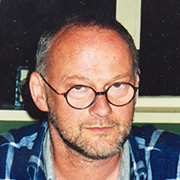
Norman Sievewright
Norman Sievewright was born and bred in Dublin, Ireland, but has spent most of his working life in Aotearoa directing live news and current affairs television. At age 18, he was advised by his headmaster that he had no academic future — a moment Sievewright now considers to be one of many “lucky breaks” that set him up for a fascinating television career.
Upon leaving school, Sievewright enjoyed a brief stint as the assistant backstage manager of Ireland’s National Theatre The Abbey, but quickly found the opportunities in theatre to be limited. With family already living in Christchurch, he decided it would be "a good adventure to move to the other side of the world”.
As his father owned a drapery shop back in Ireland, Sievewright took a job at the Ballantynes department store for 10 months, before landing another "lucky break". A family friend put him in touch with the NZ Broadcasting Corporation; a week later he was on the payroll. Sievewright began his screen career in 1974 as a Presentation Officer, whose job is to make sure that the day's television schedule screens on time.
When the NZBC was dissolved the following year— replaced by Radio New Zealand, and two television channels – he joined TV Two in Auckland. Up until this point, Presentation Officers had helmed news programmes, but when the news executives decided they needed their own dedicated directors, Sievewright took on the challenge. The job was hard work – six days a week of high pressure – but he found the intensity "rewarding and very grounding".
"It suited my inherent megalomania. I enjoyed the pace of it, and only having one chance of getting it right… I didn’t think I would want to make long form programmes, it didn’t suit my personality. I loved the risk of it."
Sievewright was a natural fit for live studio directing, and quickly became a fixture of news programming. Although based in the Auckland studios, he also supported smaller stations as needed, such as the Hamilton station before it was closed down. During the mid 1970s, Sievewright would travel to Hamilton on a Monday, work the week, then be back in Auckland by Friday night in time to be in the main studio on Saturday. Sunday was his one rest day, before repeating the cycle again. "It helped me buy my first Land Rover," he quips.
With a news career spanning almost five decades, Sievewright has been involved in covering many world events. He remembers the 1979 Erebus disaster as the first major story he was involved in covering, with other memorable work days including the Chechen hostage crisis of 1995, Princess Diana’s death in 1997 and September 11 (not to mention the semi-planned chaos of election nights). He describes such major news days as "all hands on deck — people come in on their days off, their nights off, everyone comes in. People are making cups of tea, bringing in baking. There’s a great sense of purpose."
Sievewright eventually became a Senior News Director at TVNZ, and began directing for current affairs television alongside the news. Throughout the 1990s, he directed for such programmes as Frontline, Counterpoint, Fraser and 60 Minutes.
"I felt lucky doing those sorts of current affairs programmes. I was acting as the eyes of the audience, the viewer at home, being able to select shots that helped them understand the dynamics of what was happening in the studio… catching the roll of the eyes, a wry smile, or the reaction to a question or answer."
He continued to develop this directorial drive of "responsibility to the audience" throughout the 2000s, helming such major current affairs shows of the era as Face to Face with Kim Hill, Eye to Eye and Holmes.
As a senior director, Sievewright was often involved in the launch of new programmes, ensuring they fitted within the style and parameters of TVNZ. As well as various re-brands of the nightly news, he contributed to the look and feel of such shows as Assignment, Top Half and Holmes. Political chat show Back Benches – filmed live in a Wellington pub next to the Beehive – was a a step away from the standard studio style.
"We had the same opening and closing, but no idea what was going to happen in between. It was pioneering TV, doing it near parliament near the politicians' favourite watering hole. The audience grew over the years."
Aside from a one year sabbatical in 1999, consulting for RTÉ News in Dublin, Sievewright's credits are a slate of many of New Zealand's most prominent news and current affairs shows. "Mark Sainsbury and I are good friends. We always say we were so blessed and lucky to spend the years we had in broadcasting; the money, opportunity, challenges, camaraderie. It was a time of change, and there were some great shows."
Sievewright left in TVNZ in 2017, deciding the move from analog to digital systems marked the perfect time to pass the baton onto the next generation. "There were younger people working in the news department who were better suited to the job, " he says. "Being able to hire people, give them a chance in broadcasting and watch them grow....I hope I put back in what I took out."
Profile written by Rosie Howells; published on 20 July 2023
Sources include
Norman Sievewright
Ngā Taonga Sound & Vision website Accessed on 20 July 2023